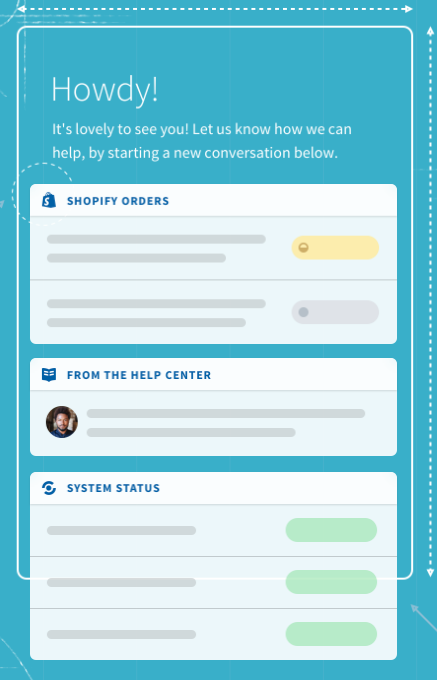As technology and consumer behavior evolve, the way we provide customer service and support should, too. Until recently, customer service’s role was primarily reactive, addressing specific complaints as they arise—reacting to customer service issues after they happen.
That’s changing.
Data around consumer preferences, a focus on customer experience as a competitive advantage, small and agile teams…all of these factors have combined to spur the popularity of proactive customer service. According to InContact’s recent study, a whopping 87% of customers want companies to reach out proactively about customer service issues.
And proactive customer service can do more than boost customer happiness—when Sam’s Furniture (a US-based retailer) began encouraging customers to start a live chat, they saw a $50,000 boost in monthly sales. Being proactive about customer service can help ease the burden on small support teams, too, reducing phone calls by 20-30% over one year.
No matter how big or small your customer service team, providing proactive customer support on live chat can help you reap big rewards.
How to use live chat proactively
Providing proactive customer service means more than just offering live chat on your website. Live chat is a valuable tool for proactively serving customers—but you have to use it the right way. That ‘right way’ varies depending on your team’s specific goals for proactive support.
The first step, as with any endeavor, is to outline your ideal outcome. When used correctly, proactive customer service can promote customer happiness, boost sales, and lighten the load on small, overburdened customer service teams. What are you hoping to get out of proactively using live chat? You might be looking to:
- Engage warm leads (who arrived on your site from email, content, referrals, etc.),
- Upsell to your existing customers,
- Handle objections from return visitors who haven’t converted, or
- Step in when customers are idle on support or FAQ pages.
With that outcome in mind, you can use the best live chat tool to engage with the right audience, provide visitors the information they’re looking for, and create a feedback loop to continuously improve.
Engage with the right audience
Customers love live chat—so much so that simply adding it to your website can boost revenue on its own. On the back end, you can do so much more to help your team make the most of live chat. Leveraging live chat to the fullest means you have to get smart about how your team’s bandwidth is allocated.
That starts with engaging the right audience. The right audience is engaged and ready to buy—and there are a few different ways you can set up your live chat tool to ensure support agents proactively engage with these customers.
Page depth
Website visitors who are highly engaged tend to browse through more than just 1 or 2 web pages. In Kayako Messenger, you can specifically target leads who’ve visited a minimum number of pages. Once someone hits page 3, your live chat software can send a curated message, like “Have questions? Start a chat with one of our live agents below.”

Time on page
In the same way, when visitors spend a long time on one page, it’s likely they’re in the midst of a purchase decision. That’s a perfect opportunity for your customer service team to handle objections, provide additional support, or help with placing an order. In Kayako Messenger, simply set the time on page minimum. A good benchmark is to set it just above your average time on page (you can find that in Google Analytics.)

Chat box visibility
While you’d love to offer live chat customer service to everyone who visits your website, that’s hard to do with a small team. For that reason, it’s important to highly target which pages display your live chat box. You might, for example, only display the chat box on product pages (which lead directly to a sale) and support pages.
Give visitors the info they’re looking for
Proactive customer service is all about streamlining the support experience—for customers and your team. One of the best ways to do that is by eliminating unnecessary chat conversations before they start.
Limiting the number of chat conversations keeps customers happy and lightens the burden on your small team—enabling agents to provide stellar service in chat conversations that do happen…and, again, keeping customers happy.
The best way to cut down on chat conversations is to give visitors all the information they’re looking for, upfront in your chat app. With Kayako Messenger, you can communicate all the important stuff on your home screen.

A few key details to include:
- Chat availability—when are your agents available for live chat?
- Order management information—order status inquiries, where to find tracking information, how to place a duplicate order, etc.
- Updates on widespread system issues. Is an outage or bug affecting a large number of customers? Share updates on the problem, timeline, and what you’re doing to fix it. You can even display social updates like your Twitter feed.
- Your FAQs. You have an FAQ page for a reason—use it to nip unnecessary chat conversations in the bud.
Learn and grow
Being able to proactively serve customers and anticipate their needs means you have understand your customers on a deeper level. While data and research can get you part of the way there, they’re no substitute for genuine conversation. The more you talk, the more you learn, the more you know about your customers—what bugs them, what confuses them, and what you can do to proactively fix those issues.
That’s why cultivating a feedback loop is essential to seeing success with proactive customer service. With every support chat, get in the mindset of asking, How could this chat conversation have been avoided? Look at every customer problem as a chance to learn, grow, and improve the experience you leave customers with.
You can then use those learnings to:
- Improve staff training
- Create, add, and improve FAQ content
- Update website copy, navigation, or design
- Improve your product, website, or app’s user experience
Ultimately cutting down on customer frustration and the load your customer service team has to carry.
Co-design and co-development
Your customers—and the customer service agents who talk to them all day, every day—are a veritable gold mine for product development and design. Designing the most seamless experience for customers is a big part of proactively serving them.
That’s why the most successful companies bring customers and customer service team members together with product development and design. They draw on real customer feedback to find the best solutions to real customer problems.
Be proactive about serving your customers
According to our live chat report, almost 4 in 10 customers say they’re more likely to buy from companies who offer live chat—but just offering live chat customer service isn’t enough. In the same report, we found that 47% of consumers haven’t had a positive live chat experience in the last month. There’s a wide gap between customer expectations and the way companies are doing live chat customer service.
That gap is your opportunity. To delight customers and create effortless experiences, you have to provide top notch customer service and support.
Whether your team is small or just crazy busy, implementing proactive customer service is the best way to serve customers a seamless experience without taxing your limited bandwidth.
[hs_action id=”9889″]

